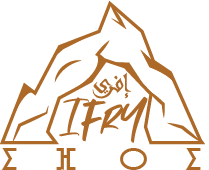Project goals:
The aim of this project is to highlight all the values of the tribe’s tangible and intangible heritage:
The village of Zaouiat Sidi Abdeslem, as its name suggests, is a “Zaouïa”, a village with a sacred character housing the mausoleum of a local Islamic figure who played a historic role in the life of his community from a social and cultural point of view, through the development of ideas and the dissemination of knowledge. This mystical ancestor, this protective and founding figure, is called Sidi Abdeslem, and is still honored by the local people, receiving offerings from pilgrims who come from far and wide to implore his blessing. It is believed that he continues to preside over the destinies of the Chorfas, his descendants.
The village of Ifrane, a word which means The Caves, because the habitat of this population is troglodyte: the caves, barely visible from the outside, which pierce the limestone rock on the hillside, right up to the banks of the river, are numerous, offering natural shelters with exceptional thermal qualities. The community’s way of life is based on pastoral activity and the art of weaving; the ties that bind each member to the group and the clans to each other are constantly maintained and renewed at annual gatherings or simply through necessary exchanges, regular meetings and strategic unions that give rise to festivals and oratorical competitions. To this day, the Berber-speaking tradition remains the vehicle for oral exchanges and the heart of the culture. The scholar Sidi Abdeslam is, in the well-known phrase used to describe the Maghreb’s strategic position between East and West, the true ferryman of civilization who gave Morocco its distinctive, multiple, plural, elusive yet deeply rooted character.
The French troops who entered from the east of the country occupied Oujda in 1906, signed the Protectorate with Sultan Moulay Abd El Hafid in Fez in 1912 and arrived on the high plateau over the following months, sometimes dealing with the tribes that reigned there (Aït Seghrouchen, Aït Naman, Aït Wallal…) and sometimes forcing them into exodus, as was the case with the Chorfas of Ifrane who fled the advance of the soldiers by taking refuge in Fez. ) or forcing them into exodus, as was the case with the Chorfas of Ifrane, who fled the advance of the soldiers by taking refuge in the middle of the winter of 1913-1914, without shelter or resources, in the Guigou mountains. In the Tizguit valley, the settlers discovered paradise on earth. In order to lay the foundations of the future Ifrane town, which was to usurp the name of the Sidi Abdeslem Zaouïa and thus eclipse the very existence of the valley’s inhabitants, the tribe’s pastoral land had to be requisitioned: The coloniser’s will was the subject of a vast procedure involving topographical surveys, demarcations and demarcations, censuses and various negotiations in order to establish the zone of influence and occupation and therefore the rights of the neighbouring tribes who are now fighting over this territory which dominates the valley, traditionally known as Tourtit, the garden of the Chorfas, where the rainwater flows and gushes out in numerous springs feeding the river, where lakes and meadows stretch out.
The project consists of reviving the intangible heritage of the tribe through the following activities:
- Awareness-raising activities on the Tribe’s heritage for the region’s younger generation to highlight the usefulness of heritage;
- Revival of the festival (Fantasia, Folklore “Ahidouss” relay of intercultural exchange) and its historic role in the conviviality of the community from a social and cultural point of view and the enhancement of various forms of artistic, heritage and creative expression through activities that enable the sharing, promotion and celebration of the community’s culture for better socio-economic and sustainable development;
- Digital recording of the various festival activities to contribute to the enhancement of the region’s heritage;
- Highlighting and disseminating activities via the “Ifrane Al QADIMA” website, developed to strengthen digital communication: https://e-ifry.com/
